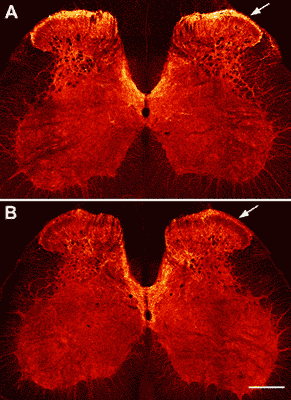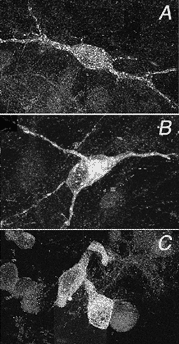 Nerve cells with substance P receptors in the spinal cord transmit chronic pain signals to the brain. Image A shows nerve cells with substance P receptors illuminated (arrow) near the surface of the spinal cord's dorsal horn 28 days after infusion of inactive saline solution. Image B, taken 28 days after infusion of the SP-SAP compound, shows few substance P receptor-containing nerve cells illuminated in this area, indicating that the compound destroyed these chronic pain-transmitting nerve cells. Images reprinted with permission from Science, October 10, 1997.
Nerve cells with substance P receptors in the spinal cord transmit chronic pain signals to the brain. Image A shows nerve cells with substance P receptors illuminated (arrow) near the surface of the spinal cord's dorsal horn 28 days after infusion of inactive saline solution. Image B, taken 28 days after infusion of the SP-SAP compound, shows few substance P receptor-containing nerve cells illuminated in this area, indicating that the compound destroyed these chronic pain-transmitting nerve cells. Images reprinted with permission from Science, October 10, 1997.The goal of developing more effective medications to treat chronic pain may be a step closer to being achieved, thanks to a new approach to blocking pain signals. The approach, which selectively destroys a small cluster of spinal cord neurons that transmit pain signals to the brain, dramatically reduced persistent pain in rats, according to a recent NIDA-supported study. The precision of the approach promises substantial relief from chronic pain without the adverse effects of current remedies such as opiates and surgery, the researchers say. Opiate medications can produce sedation, constipation, and physical dependence, and surgical procedures to relieve pain may result in permanent partial paralysis.
Chronic pain is a complex, difficult-to-treat condition. Unlike acute pain, which ends when a pain-causing injury is healed, chronic pain can persist following prolonged tissue or nerve injury. "It's hard to imagine the life of a chronic pain patient," says Dr. David Thomas of NIDA's Division of Neuroscience and Behavioral Research. "The pain is with them every moment, disrupting all activity." To relieve their pain, chronic pain patients often go through extreme procedures, such as cutting nerves or removing parts of the brain. These procedures damage additional nerve fibers that control other sensations and movement, pose a risk of paralysis, and may provide only temporary pain relief.
In contrast to such procedures, the pain-relieving technique developed by a team of researchers led by Dr. Patrick Mantyh of the University of Minnesota and the Veterans Affairs Medical Center in Minneapolis is both benign and effective. The researchers bonded a nerve toxin to a chemical that certain nerve cells normally absorb as part of the pain-transmission process. When the researchers infused this compound into the spinal cord of laboratory rats, pain-processing nerve cells in this area absorbed the chemical as usual, bringing the bound nerve toxin into the cell as well. Once inside the cell , the nerve toxin killed the cell, stopping the transmission of pain signals. Since only targeted pain-transmitting cells absorbed the toxic compound, no other cells were harmed. Thus, the treatment significantly reduced chronic pain without any apparent adverse side effects.
In developing the treatment, Dr. Mantyh's team focused on nerve cells that rely on a chemical called substance P (SP) to transmit pain signals from different parts of the up the spinal cord and into the brain where pain is perceived. In chronic pain syndromes, nerve cells in the spinal cord that are activated by SP become sensitized to the chemical in response to prolonged inflammation or nerve damage from illnesses such as arthritis, cancer, herpes, or HIV/AIDS. Even moderate quantities of SP released in response to a mildly painful stimulus abnormally excite these sensitized nerve cells, and they keep firing inappropriate pain signals to the brain. As a result, chronic pain sufferers may feel extreme pain from stimuli that usually produce only mild pain, such as warm water, or sensations that normally are not painful, such as the brush of a feather.
 Nerve cells with substance P (SP) receptors were treated with the SP-SAP compound. Image A, taken 2 hours later, shows the receptors on 1 of these nerve cells as it starts to take the toxic compound from the cell membrane into the cell . Image B, taken one day later, shows that the SP receptors and their toxic cargo remain active within the cell . Four days after treatment, most neurons with SP receptors were eliminated. Surviving nerve cells, such as the two shown in image C, have withered projections and shrunken cell bodies as they continue to die off. Images reprinted with permission from Science, October 10, 1997.
Nerve cells with substance P (SP) receptors were treated with the SP-SAP compound. Image A, taken 2 hours later, shows the receptors on 1 of these nerve cells as it starts to take the toxic compound from the cell membrane into the cell . Image B, taken one day later, shows that the SP receptors and their toxic cargo remain active within the cell . Four days after treatment, most neurons with SP receptors were eliminated. Surviving nerve cells, such as the two shown in image C, have withered projections and shrunken cell bodies as they continue to die off. Images reprinted with permission from Science, October 10, 1997.In early studies, the researchers showed that a compound made up of SP and a potent nerve toxin-called saporin (SAP)-would lock onto, be taken into, and destroy nerve cells that have portals on their surface-called receptors-designed specifically to absorb SP. In a recent study, the researchers injected the compound, called SP-SAP, into the lumbar region of the spinal cord of rats, infusing the compound into an area called the dorsal horn where nerves carrying pain signals from different parts of the converge and pass pain impulses up to the brain. The study showed that rats treated with the compound had a significant loss of nerve cells with SP receptors in the targeted area 30, 100, and 200 days following treatment.
After administering the compound, the researchers waited 30 days for the nerve toxin to work, then induced either nerve pain or inflammatory chronic pain conditions in the rats. When heat or mechanical stimuli were subsequently applied, rats treated with the compound showed markedly reduced pain responses compared to rats treated with an inactive saline solution or SAP alone. Rats treated with the SP-SAP compound 7 days after nerve injury had occurred also showed reduced sensitivity to pain. "The pain reduction is profound," Dr. Mantyh says. Furthermore, the reduction in chronic pain appeared to be permanent in rats. "We tested it out to 200 days, which would be equivalent to decades in human terms," he says.
"The beautiful thing about the technique is that the targeted neurons are doing the work for you," Dr. Mantyh says. "We simply present the toxin to all the neurons in this area and they take it up only if they have this receptor for substance P." Neurons with the SP receptor, which were destroyed by the treatment, constitute less than 5 percent of the nerve cells in the area of the spinal cord where the compound was administered. The study suggests that this small population of neurons with SP receptors in the spinal cord plays a significant role in the generation and maintenance of chronic pain, Dr. Mantyh says.
"The treatment reduces but doesn't completely eliminate either severe or chronic pain," Dr. Mantyh notes. "This means you can still feel some pain, but it doesn't change the quality of your life completely as chronic pain does when it is untreated." In addition, the technique preserves morphine's ability to relieve pain. Therefore, clinicians would still be able to provide relief for breakthrough pain if needed, he says.
If the compound proves safe and effective in humans, clinicians would be able to kill pain-transmitting nerve cells simply by making a small injection into one little area of the spinal cord where they are located, says NIDA's Dr. Thomas. "Spinal injection of other compounds is a common clinical procedure, and I think that the use of the SP-SAP compound could eventually help a lot of people," he says.
Before they can use the technique in humans, the scientists must conduct toxicology studies in larger animals to confirm that the treatment is safe and can work in other species. If these studies succeed, the researchers will seek approval to treat terminally ill patients who have severe chronic pain, Dr. Mantyh says. "We hope we will be able to reduce significantly the enormous pain suffered by cancer patients," he says.
Sources
- Mantyh, P.W., et al. Inhibition of hyperalgesia by ablation of lamina I spinal neurons expressing the substance P receptor. Science 278(5336): 275-279, 1997. [Abstract and Full Text]
- Nichols, M.I.; Allen, B.J.; Rogers, S.D.; Ghilardi, J.R.; Honore, P.; Luger, N.M.; Finke, M.P.; Li, J.; Lappi, D.A.; Simone, D.A.; and Mantyh, P.W. Transmission of chronic nociception by spinal neurons expressing the substance P receptor. Science 286(5444): 1558-1661, 1999. [Abstract and Full Text]
